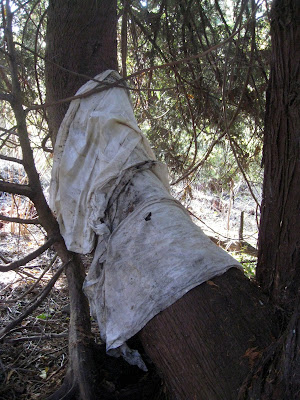A journal where I share my adventures developing a food forest based on permaculture principles. I also share my love of knitting here. For my life as a textile artist follow me at lesleyturnerart.com
Saturday, April 14, 2012
Friday, April 13, 2012
Tree Cloths & Time

Not time as measured by a clock or calendar. I saw evidence of time each time I emptied the 7 threaded needles I took out to the tree. I felt time through my working hands. I saw changing time as the number of stitched rows increased. I saw time in the changing bands of colour on the sheets as the tree responded to climatic changes.

Rather than follow the Gregorian calendar to tell me when it was time to do the next colour study, I decided to follow the moon phases because they are linked to growth cycles in all living things.
I settled on the day of the new moon, a time of new growth.

Early human artifacts show marks recording moon cycles. Many North American Aboriginal tribes named each moon phase according to what they observed happened in nature.
From November 24th to December 24th I lived without watching any TV, reading newspapers, or listening to the radio. I went to bed when I was tired and got up when I woke up. I was mostly on my own and spent the time stitching and walking outside observing and listening. I wanted to develop a more instinctive awareness of time. I became aware of time in the present and stopped continually thinking of time as always passing me by.
Thursday, April 12, 2012
Challenges While Stitching Outside

I quickly became aware of the challenges of stitching outside while the bed sheets were wrapped around the trees.
I live in a "rain" forest area so the sheets were often wet. Thread doesn't slide very well through wet cloth.
So no stitching when the cloth is wet.

The daily temperatures dropped. I wore more layers to keep my core warm but found my cold fingers couldn't move the needle well enough below 8 degrees after half an hour of stitching.

While working on the sheet I disturbed the wildlife. I liked it when spiders ran over my fingers - I felt connected. But I was not keen on connecting with wasps hibernating in this new condo they had found. They hung on by their mouths and made low slow buzzing noises when I moved the sheet. I was pleased when they decided to relocate.

Another challenge was, apart from stitching along the bottom hem, how was I going to stitch on the sheet while it was wrapped around the tree?
Having found out I could stitch only when the cloth was dry and it was above 8 degrees, I realised I wouldn't be able to stitch outside many days between October and spring. I needed to put more thought into realising my concept.
Wednesday, April 11, 2012
Tuesday, April 10, 2012
Monday, April 9, 2012
Sunday, April 8, 2012
Eco-Printing aka India Flint & More Sampling

Did I need to leave a body print, visible evidence I have touched the cloths and left my DNA, just as the trees have done?
Image of Colin Jenkins' stitched body print 'Purge' - (Source: Embroiderers' Guild (2006) Art of the Stitch Scholar, Surrey: EG Enterprises, p. 14).

Or maybe stitch into the cloth with my own dentritus, my hair?
Image of Tabitha Kyoko Moses' self portrait, stitched with human hair - (Source: Embroiderers' Guild (2006) Art of the Stitch Scholar, Surrey: EG Enterprises, p. 36).
I sampled but didn't feel the efforts added to my understanding of the trees I wanted to get to know.
Saturday, April 7, 2012
In Praise of Ironing

'In Praise of Ironing'
It has to be spread out, the skin of this planet,
has to be ironed, the sea in its whiteness;
and the hands keep on moving,
soothing the holy surfaces.
poem by Pablo Neruda

I continued to search for a way to respond to the marks the tree left on the cloth.
I rejected making a bed and decided laundering them would remove the marks.
Could I just iron the sheets and fold them up?

(Source: Google Images, extreme ironing)
My research showed much belittling of the domestic activity of ironing so the action would not necessarily strengthen my work.
Pablo Neruda's poem 'In Praise of Ironing' uses ironing as a metaphor for controlling natural biological processes, the antithesis of a harmonic relationship I wished to express in my work.
Friday, April 6, 2012
Considering Making a Bed

(Source: Google images, source unknown)
I wondered how I would respond to the trees' staining on the bed sheets. Could I make a bed? How have other artists used beds?

Bed linen enveloped in natural biological cycles - repulsive rather than inviting.
(Source: tigeyguz's Flicker photostream)
(Source: tigeyguz's Flicker photostream)

Stitching the bed. Jane McKeating's book on a double bed is a metaphor for her relationship with the other person who shares her bed, or did share it.

Tracey Emin's My Bed, 1998-1999, installation, Japan to Tate to The Saatchi Gallery to New York.
Tracey wanted the installation to look as though a bed had been taken out of a bedroom and put in a gallery space.
There are many other artists who have 'made beds' - Patricia Jauch, Frieda Kahlo, Robert Rauschenberg. The problems for me are the bed has for so long been used as a signifier of human relationships and a bed made from tree stained sheets would be associated with the idiom, 'airing one's dirty laundry in public.'
Thursday, April 5, 2012
Subscribe to:
Comments (Atom)





























